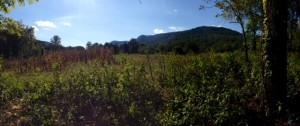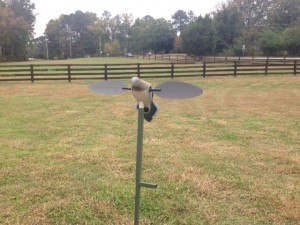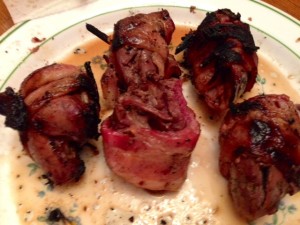The story was updated December 2, 2013 with a multimedia at the end of the story.
The sun had shifted from directly above to directly over the trees on the opposite side of the blown down corn field, leaving no space for shade except the slat right behind the trees we were standing under. We had to stand under the trees on the edge of the woods for camouflage. Our short-sleeved camouflaged t-shirts became sweaters in the mid-afternoon September heat. Gray decoys perched on the ground and on broken corn stalks, feigning food and safety. The Mojo Voodoo Dove Decoy’s wings flapped restlessly in stationary flight. Suddenly, a gray mass arose from the line of treetops on our left and flew towards us in synchronized disarray. Individual mourning doves swarmed and dove towards the decoys, frightened out of their safe havens by some unknown interruption, and Matt Bodenhamer and Zack Davis
raised their shotguns.
My first dove hunt began on a hot September afternoon in the Green River Game Lands of Henderson and Polk counties. The Green River Game Lands are over 10,000 acres of forest set aside for management and conservation of the wildlife in the Green River Gorge. Hunting, fishing, and trapping are allowed on the game lands, as well as hiking, at risk to the hiker during hunting season.
“The section of the Green River Game Lands that we hunted has got to be one of the most beautiful places in all of Polk and Henderson counties. It has one awesome panoramic view of an old homestead farm and mountains surrounding it. You couldn’t ask for a better habitat for doves,” said Zack Davis, an NC State Fish and Wildlife major and dove hunting companion.
Matt and Zack attend NC State University as Fish and Wildlife majors and have both dove hunted for a while now. For both men, dove hunting originated from a love of hunting in general. For Matt, it started in a cut soybean field with a couple of friends, a couple of shotguns, no decoys and no idea how to hunt them. When a few flew overhead, he shot two, and from then on was inspired to learn about their habits, how to harvest them and how to sustain a better population of mourning doves. For Zack, it began in high school when his agriculture teachers, who were avid dove hunters, took him for the first time.
“I didn’t get to shoot a dove that day, but I did get to shoot at some, which got me hooked, and since then I’ve been going several times a year. I fully intend to continue dove hunting and make it a tradition for my kids,” Zack said.
According to the Fish and Wildlife Service’s 2013 “Mourning Dove Population Status Report”, mourning doves are one of the most abundant bird species of North America. The migratory birds are managed by the US Fish and Wildlife Service and annual hunting regulations are made according to results of population assessments throughout the year. In the past two years, North Carolina has had the highest annual count of mourning doves. The most recent absolute abundance estimates concluded that there were 349 million mourning doves in the United States in the 2012 preseason and the numbers continue to rise. Mourning doves are abundant in southern Canada, throughout the United States into Mexico, Bermuda, the Bahamas and Greater Antilles, and in scattered locations in Central America.
The blown over corn and millet fields, surrounded by trees and forest, provide an ample habitat for mourning dove. According to an article, “Mourning Doves”, by Dan Hicks, doves are attracted to many different seeds and grains such as sunflowers, millet, grain sorghum, corn, buckwheat and sesame. For hunters looking to hunt the mourning doves, they should seek out a large, open field with structures such as trees or power lines, as doves like to perch and loaf around ideal areas.
The Green River Game Lands make for a perfect habitat for the mourning doves that we were hunting.
“It was the first time that I have ever been on the Green River Game Lands. The NC Wildlife Commission has worked tremendously hard on this land to manage it correctly and supply the general public with not only a breathtaking landscape, but a land full of hunting opportunities. We walked over a mile and crossed a small creek where most people are not willing to travel. The gently sloping land was filled with patches of corn, millet, and pokeberry,” explained Matt Bodenhamer.
Several times during our hunting trip, one or the other of us would take out from the cover of trees and walk around the field in order to find where the birds were perching when they weren’t flying. I walked with Zack on the first of these excursions. We kept our eyes peeled for lone doves diving from treetops and, sure enough, they had moved to the opposite end of the field. He put his hand out to stop me from walking any further and we moved towards the edge of the trees where they were perched and waited. Two doves flew out from their safe haven and Zack raised his shotgun to his shoulder, took aim at one of the birds, and shot. The bird tucked away back into the safety of the trees, unharmed, but it wasn’t long before we heard several shots ring out over the hill.
The only gun allowed to be used to kill doves is a shotgun that holds no more than three shells. A shotgun allows the hunter to have a broader range of shot and better chance of getting a bird as the doves are quick and fly in sporadic patterns.
“Where a rifle shoots a single projectile round at a designated target, a shotgun shoots many different small bead-like projectiles known as shot. Shot is contained in a shell that consists of the powder wadding and the shot,” Matt explained.
We crested the hill and found Matt in amongst the trees again, with a few doves at the trunk of the tree. The sound of Zack’s shot had spooked the doves on the edge of the corn field out of the treetops and Matt was able to bring a few down in their frenzy. The doves fly from the treetops towards the decoys because the dove decoys make the birds think there is a food source and that it is a safe place for them to land.
For Zack, the most exhilarating part of dove hunting is the natural instinct he feels.
“When the doves are almost in range there is that moment of anticipation, you’re raising your gun to get the bird in your sights all the while your mind is focused on the shot. For that brief moment you don’t think, you simply let your instincts follow the bird and when it’s in range you pull the trigger. That’s the exhilarating part, being able to do something without even thinking, like its second nature.”
By the end of the day, we walked away with six doves.
According to the US Humane Society’s website, mourning doves are a “farmer’s friend” bird and should not be hunted.
“[Doves] are too small to provide any sustenance, they don’t cause any problems, they’re not overpopulated. These birds don’t cause car accidents, they don’t knock over your trashcans, they don’t spread diseases. These are gentle, inoffensive, backyard songbirds and they should not be treated as game,” said Michael Markarian of the US Humane Society in a Youtube video on the society’s website.
However, according to the Fish and Wildlife service, hunting mourning doves is a healthy way to keep the population maintained. All of the doves that Matt and Zack shot were made into dinner that same night, as well. Dove breasts are small, but can make a substantive meal with quantity and the right seasoning. Dove mean is dark and delicate and made a delicious post-hunt meal.
“The best way to clean a dove is by breaking off both wings and pinching the lower end of the breast plate. There is a gap between the breast and the anus where the skin can be pinched. Grip it tightly and pull the skin towards the head. This will sever the skin and feathers. Gently push on both sides of the breast and the skin and feathers will slide off. After the feather removal, push your thumb underneath the breast plate and lift up,” Matt explained.
Both men had similar ways to cook the meat as well, of their own creation, both involving the breasts being wrapped in bacon. Zack prefers to season his dove meat simply with salt and pepper, while Matt enjoys marinating his.
“Some argue that mourning doves are the most succulent bird meat of the game species in NC. Their meat is extremely tender which allows it to soak up marinades well. My favorite recipe is marinated dove breast wrapped in hickory smoked bacon. It is as simple as it sounds. Simply put your dove breasts in a bag and marinade them with your favorite marinade for an hour. Wrap the bacon around the breast and use toothpicks to hold it in to place. Cook it slowly on the grill and that is all that you have to do. My favorite marinade is Allegro original,” Matt explained.
I had never tasted dove before this hunt and, having raised a mourning dove that had fallen out of a nest some years before this, was a little hesitant. Wrapped in bacon, however, it didn’t look so much like the bird I had raised as a pet. As I took my first bite of the succulent meat, I was surprised at the lack of gamey taste I have experienced in the meat of other wild animals such as deer. The breast is approximately the size of a chicken nugget yet laden with rich meat, nonetheless. Because the breasts are so small, they drank in the marinade and were dripping with flavor. Paired with the bacon, green beans, cornbread, mashed potatoes and sweet tea, the dove made for a mouthwatering country dinner that I could look forward to every dove season.
For the 2013 dove hunting season, hunters are only allowed to have 15 doves per day in their individual possession and 45 doves per group. Doves are a migratory bird and, therefore, are protected and managed by the NC Wildlife Resources Commission and the dove season dates are determined by mating season. The NC Wildlife Resources Commission conducts studies each year to ensure that doves are not being harvested during mating seasons. The 2013 dove hunting season dates, according to the NC Wildlife Resources Commission Website, are September 5 through October 5, November 25 through 30 and December 13 through January 11.
The video below displays graphic images of doves being cleaned and prepared for cooking:







